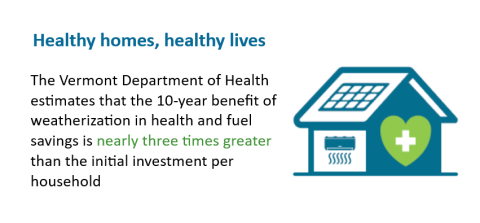
This commentary by VHFA Executive Director Maura Collins appeared recently on VTDigger
There is only so much room in our budgets for housing, heating, and transportation, and when we sit down to pay our bills it’s clear how inextricably linked each of these are.
When thinking about our budgets, too many Vermonters are faced with an affordability crisis. Volatile fossil fuel prices and old, leaky homes combine to make winters uncertain and uncomfortable.
Limited housing available downtown can drive up prices and push lower income Vermonters out to rural areas where housing seems cheaper, but longer commutes eat up any savings through more gas, costlier car maintenance, and precious time.
Climate change makes these problems worse. The dramatic freeze-thaw cycles we’ve seen this year (and that will continue as the climate destabilizes) makes car maintenance even more expensive. Bigger, more frequent potholes and more days of salting icy roads take their toll on Vermonters’ cars.
And Vermonters can’t afford it. They can’t afford homes damaged by worsening storms and big temperature swings. They can’t afford running inefficient air conditioners in poorly insulated homes when we deal with record hot temperatures (I know it seems impossible this winter, but they will come!).
Vermont Housing Finance Agency is focused on affordable, safe and decent housing. And we know that making energy more renewable, efficient, and cost effective can help make housing more secure for Vermonters. The costs of home energy and transportation along with mortgage payments (or rent), home insurance and taxes are part of every Vermonter’s monthly expenses. By reducing the total burden of these costs, we can improve the long-term affordability of living in Vermont, and stabilize the economy.
The report published this week by the Energy Action Network (EAN) is a call to action. EAN’s 2018 Annual Progress Report focuses both on the cost of the status quo for Vermonters as well as the benefits if we reduce our dependence on fossil fuels and reduce emissions through steps such as increased home weatherization.
EAN’s report models the scale of transformation necessary to reach Vermont’s commitment to the Paris Climate Agreement by 2025. One third of all homeowners would need to switch from propane or fuel-oil heating systems to renewable options like advanced wood heating (pellet stoves and boilers) and cold climate heat pumps over the next six years.
This isn’t just about emissions. Our reliance on fossil fuels cost Vermonters $240 million more in 2018 than if we had been heating our homes and businesses renewably.
Worse, of that $240 million, over $185 million left the Vermont economy entirely, since about 78 cents of every dollar spent on fossil fuels leaves Vermont and goes to other states and countries. I’d much rather invest those dollars in Vermont businesses and families.
It’s not just how we fuel these homes, but also where that fuel goes: out the windows or staying in the home. EAN also models the impact of weatherizing an additional 90,000 buildings over the next six years. The report cites the Vermont Department of Health’s finding that the 10-year savings from weatherization is nearly three times greater than the initial investment, thanks to both health and fuel savings.
When Vermont Housing Finance Agency funds affordable apartments, we require high energy efficiency standards. We give priority to applications that are efficiently located near jobs and services in downtowns and village centers with access to public transportation. VHFA also prioritizes buildings that meet Passive Housing or Net Zero construction standards.
In doing this we recognize that housing needs to be affordable for the life of the home. Our residents deserve it.
The EAN Progress Report is a must-read for anyone who is thinking about how energy impacts our economy, our health, and our climate. I look forward to more informed conversations about why and how we need to accelerate efficient renewable energy adoption for the sake of all Vermonters.
